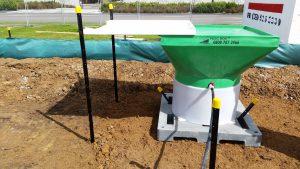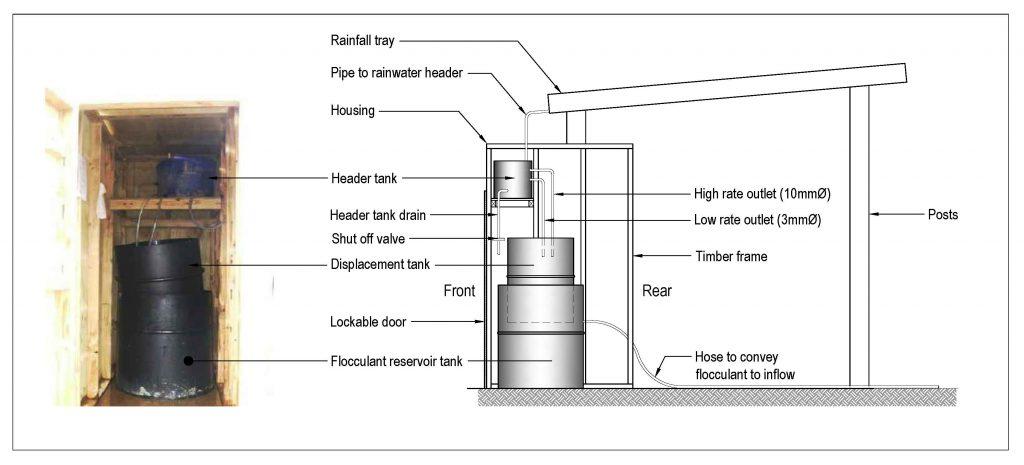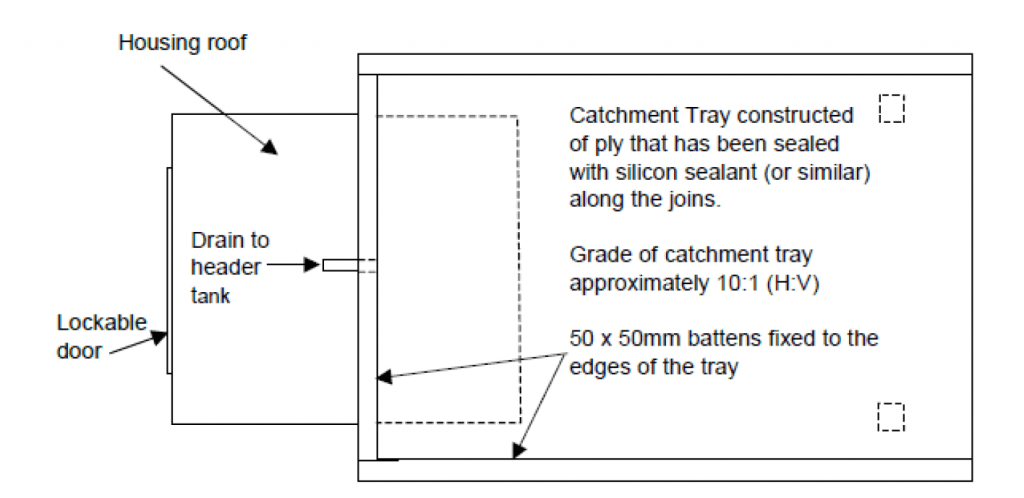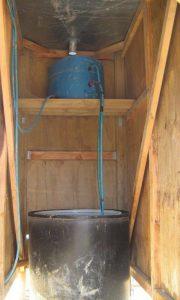Sediment Control
Coagulants and flocculants:
Rainfall activated
What, why and when
What
Rainfall-activated treatment devices operate as follows:
- Rainfall is collected in the catchment tray and discharged to the header tank
- The header tank provides storage capacity to avoid dosing during initial rainfall after a dry period, and to attenuate (reduce) dosing at the beginning and end of a rainstorm, to simulate the runoff hydrograph
- The header tank provides:
- Zero flocculent discharge until a pre-selected quantity of rain has fallen, to allow for initial infiltration and saturation of dry ground before runoff commences
- A slow start to the dosing rate to allow for the response time of runoff flowing off the site at the beginning of a storm
- An extension of the dosing period beyond the rainfall to treat the runoff.
- From the header tank, the rainwater discharges by gravity through low and high flow outlets into the displacement tank, which floats in the flocculant reservoir tank. As the displacement tank fills with rainwater, reagent is displaced through the outlet in the flocculant reservoir tank and then flows by gravity to the dosing point.
A rainfall-activated system is appropriate for most liquid reagents. This toolbox gives details for using poly aluminium chloride (PAC) as an example reagent. You can use other types, by considering its dose rate (as determined by bench testing) and the specific gravity of the reagent in the form to be used. Many reagents need some dilution to be suitable for this system. Talk to suppliers about the options available to find the system that works the best for your site.
Proprietary rain-activated systems are now available and make this technique relatively simple. Ensure that the system set-up is in line with the toolbox and meets the requirements of your site. Use a supplier who is able help you achieve the results you need.
Why
Rainfall-activated treatment is one of the best options for treating sediment-laden runoff, because it provides an appropriate level of dosage based on the rainfall volume and intensity.
When
Rainfall-activated systems are best used with liquid reagents and are mainly used in the following situations:
- The period of treatment is long (more than 4 weeks)
- The catchment area is greater than 0.5 ha
- Earthworks are during periods of increased rainfall (eg winter)
- The site is unattended for more than 24 hours.
Design essentials
A rainfall-activated flocculent treatment device is made up of a:
- Rainfall catchment tray
- Header tank
- Displacement tank
- Flocculent reservoir tank.
The size of the rainfall catchment tray is determined by the size of the catchment draining to the sediment retention pond. The tray is sized to provide flocculent treatment for 100% of the runoff from the exposed earthworks areas, and 60% of the runoff from the stabilised contributing catchment area.
Carry out bench testing and testing while the system is running, to determine the optimal dose (see coagulants and flocculants section).
The flocculent should discharge to the turbulent section of the inlet drain, to make sure that it mixes thoroughly with the dirty water.
Rainfall catchment tray
- The rainfall catchment tray area will increase as the dosage rate or contributing area increase
- The rainfall catchment tray area will decrease as the dosage rate or contributing area decrease.
Header tank
- The zero flocculent discharge rainfall volume can be adjusted manually for site characteristics by adding or removing water from the header tank.
- The header tank needs the drain hose to be as low as practical to allow the header tank to be fully emptied and/or to adjust the zero discharge volume. This drain should include a valve for ease of use.
- Install low rate and high rate outlets.
- The low rate outlet is an outlet hose with a 3 mm orifice. The standard header tank design allows for 12 mm of rainfall before dosing starts.
- The high rate outlet is an outlet hose with a 10 mm orifice. The high rate outlet invert should be positioned at that point reached by a further 12 mm of rainfall.
- The slow start/attenuation characteristics can be regulated for site characteristics, if necessary, by providing more than one low rate outlet and at different levels from the header tank.
- The header tank should have a minimum freeboard of 50 mm above the top of the high rate outlet pipe.
Displacement tank
- The displacement tank needs to be a neat fit inside the flocculent reservoir tank. However, it should not be so tight that it could jam or prevent additional flocculent from being added.
- The displacement tank should be able to hold runoff from the 50% AEP event.
Flocculent reservoir tank
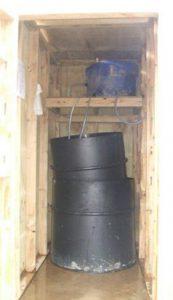
Rain passing from the header tank depresses the displacement tank and pushes flocculent out of the lower container (Source: SouthernSkies).
- The flocculent reservoir tank needs to be only slightly larger than the displacement tank. The larger the reservoir and displacement tanks are, the less servicing required.
- The flocculent reservoir tank requires sufficient capacity, set by the height of the outlet hose, to dose the runoff from the 50% AEP rainfall event.
- A 20 mm (minimum) diameter outlet hose needs to be installed in the side of the tank to drain through the side of the shed to the pond inlet channel.
- The dosing point of the outlet into the sediment-laden diversion should be at least 5 m upstream of the forebay to promote mixing of the flocculent.
Floc shed roof
To calculate the surface area of your floc shed roof, the standard calculation when using PAC is:
0.375 m² / hectare of exposed catchment, when using 2 parts per million concentration of PAC.
PAC has a density of 1.2 mg/L. If you are using 4 ppm of PAC, then use 0.75 m² of roof / ha of open area, if using 6 ppm, then 1.125 m² / ha, and so on.
For other flocculants, check the density of the chemical and apply the ratio to calculate the correct dosing rate. Suppliers will be able to help you get this right.
Construction, operation and maintenance
When constructing a rainfall-activated treatment system:
- Make sure that the shed is large enough to accommodate the various tanks without restricting their operation.
- The shed can be constructed of a number of materials. Timber-framed plywood is usual.
- The shed must be durable. Consider using lifting points or skids so that the shed can be relocated easily.
- Make sure that the shed, particularly the rainfall catchment tray, is well secured to the ground to prevent wind damage.
- Ensure the shed has a lockable door for security.
- Put the shed in a location that allows servicing and maintenance in all weathers.
When operating and maintaining a rainfall-activated treatment system
- Only implement treatment under the supervision of a suitably experienced and qualified professional
- Assess maintenance requirements before and after every rainfall event, or during exceptionally heavy and/or prolonged rainfall
- If the site will be unattended for weekends or other periods, service the treatment system so that the maximum amount of runoff can be treated by the dosing system
- The system may require some ongoing adjustment to suit the site characteristics and runoff.
Header tank
- The header tank is used to delay dosing during the initial stages of rainfall when site conditions are dry and no runoff is expected. It also regulates the discharge of reagent to mimic surface runoff, by allowing a higher outfall during heavy rainfall and by increasing the duration of discharge beyond the end of rainfall.
- Lower the volume in the header tank using the lowest of the three outlet tubes:
- After 3 days without rain, reduce the volume to 50%
- After 6 days without rain, reduce the volume to empty (level at lowest outlet).
- In wet weather, or if the site is generally wet, water may be added manually to the header tank to cut down the response time so that the system responds more rapidly after rain starts.
- If the system is to be operated over winter, consider setting it to ‘no delay’
- You can adjust the water level in the header tank to regulate under or overdosing of the pond. This should only be an interim measure until further bench testing and/or tray sizing takes place. Under-dosing can mean that higher levels of suspended sediment are discharged from the pond. Overdosing of PAC can reduce pH, raising the potential for aluminium within the PAC to react, forming toxic aluminium compounds that are bioavailable to fresh and marine water organisms.
Refilling the flocculent reservoir
- When the volume of flocculent in the reservoir tank is reduced so much that there would not be enough to dose a major storm, empty the displacement tank and refill the flocculent reservoir.
- Empty the displacement tank by using a siphon, bailing out by hand or pumping. Plan for this method in the design of the shed.
- The flocculent reservoir is best filled using a drum pump, to pump from a 200 L drum.
Monitoring and adjusting for changing site conditions
- Monitor each new treatment system carefully during the first few rainfall events to check that it is effective, and that there is no over or under-dosing.
- Changes in catchment areas and/or soils will also require a review of the treatment system design. You can usually accommodate minor changes by modifying the rainfall catchment tray. More significant changes will also require a modification of the header tank.
- If you suspect overdosing because the pond dead storage water is exceptionally clear, take samples from the pond for pH and residual chemical analysis. Adjust the dosing regime depending on the outcome of these results.
- If overdosing occurs, or if it is clear that the quality of stormwater runoff is improving because of stabilisation of the site, reduce the reagent dose by reducing the size of the catchment tray. You can do this by placing and sealing a board (batten) diagonally across the tray with a hole through the tray rim at the lower corner, so that water from the tray area above the batten discharges to waste. Alternatively, place a suitably sized piece of plywood over the lower section of the tray to reduce the tray area.
- Remove debris (eg leaves) from the catchment tray to make sure that rainwater enters the header tank. Check the low and high rate hoses regularly for blockages. Also inspect all hose fittings regularly to identify any leakages.
- Deal with issues such as poor treatment performance, or consistently very clear treated water, by consulting a suitably experienced and qualified professional.
Spill management
- If there is a reagent spill onto the ground, contain it immediately using earth bunds so that the spill can’t enter water. When using PAC, recover any spilt reagent that you can and put it in polyethylene containers. If you can’t recover it, mix it with at least ten times the amount of soil, to neutralise the PAC. Bury this soil at least 0.5 m below the ground surface.
- If there is a reagent spill into ponded water, prevent discharge from the pond to natural water. Then sample and test the ponded water to confirm whether it is safe to discharge. For example with PAC, check that the pH and or free aluminium concentration is within acceptable limits.
- If there is a spill of reagent into flowing water:
- Contact the Pollution Hotline immediately: 0800 POLLUTE
- Record the volume of the spill
- If possible, pump the water and spilt reagent into a bund or pond until all the spilt reagent has been removed from the watercourse
- If you can’t remove the reagent from the watercourse, identify and advise any downstream users.
